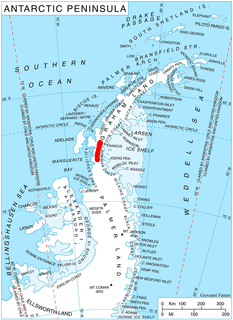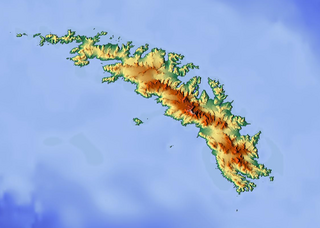Shabica Glacier is a northern tributary glacier to the Clifford Glacier, joining it near its terminus just east of Mount Tenniel, in Palmer Land. Mapped by United States Geological Survey (USGS) in 1974. Named by Advisory Committee on Antarctic Names (US-ACAN) for Stephen V. Shabica, United States Antarctic Research Program (USARP) biologist and Station Scientific Leader at Palmer Station in 1970.
Zenith Glacier is a glacier which lies 1 mile (1.6 km) west of Johnstone Glacier and drains south from the south end of Lanterman Range, Bowers Mountains. So named by the New Zealand Geological Survey Antarctic Expedition (NZGSAE) to northern Victoria Land, 1967–68, because the glacier is an important geological outcrop area with an impressive view from the top of much of the Bowers Mountains.

El-Sayed Glacier is a glacier about 15 nautical miles long which drains the northeast slopes of Zuncich Hill in Marie Byrd Land. It flows northeast to enter Land Glacier at the south side of Mount Shirley. It was mapped by the United States Geological Survey from surveys and U.S. Navy air photos, 1959–65, and was named by the Advisory Committee on Antarctic Names for Sayed Z. El-Sayed, a United States Antarctic Research Program oceanographer on the International Weddell Sea Oceanographic Expeditions, 1967–68 and 1969–70.

Explorers Range is a large mountain range in the Bowers Mountains of Victoria Land, Antarctica, extending from Mount Bruce in the north to Carryer Glacier and McLin Glacier in the south. Named by the New Zealand Antarctic Place-Names Committee (NZ-APC) for the northern party of New Zealand Geological Survey Antarctic Expedition (NZGSAE), 1963–64, whose members carried out a topographical and geological survey of the area. The names of several party members are assigned to features in and about this range. All of the geographical features listed below lie situated on the Pennell Coast, a portion of Antarctica lying between Cape Williams and Cape Adare.

Ahlmann Glacier is the southernmost of two glaciers on the east side of Hemimont Plateau flowing east into Seligman Inlet on Bowman Coast, Graham Land in Antarctica. The glacier was photographed from the air in 1940 by the United States Antarctic Service, and was charted in 1947 by the Falkland Islands Dependencies Survey, who named it for Professor Hans Wilhelmsson Ahlmann, a Swedish glaciologist and geographer.
Daspit Glacier is a glacier 6 nautical miles (11 km) long, flowing east-northeast along the south side of Mount Shelby to the head of Trail Inlet, on the east coast of Graham Land, Antarctica. It was discovered by members of the East Base of the United States Antarctic Service, 1939–41, and was originally named Fleming Glacier after Rev. W.L.S. Fleming. It was photographed from the air in 1947 by the Ronne Antarctic Research Expedition under Finn Ronne, and charted in 1948 by the Falkland Islands Dependencies Survey. It was renamed by Ronne for Captain Lawrence R. Daspit, U.S. Navy, who assisted in obtaining Navy support for the Ronne expedition, the original name being transferred to Fleming Glacier on the Rymill Coast.

Lewald Glacier is a small glacier 3 nautical miles (6 km) west of Cape Vahsel, flowing northward to the coast at the east end of South Georgia. It was named by the Second German Antarctic Expedition, 1911–12, under Wilhelm Filchner, for Theodor Lewald, Ministerialdirektor im Reichsamt des Innern, Germany, who took an active interest in the expedition.

Apollo Glacier is a glacier, 9 nautical miles (17 km) long, flowing northeast and joining the lower part of Aphrodite Glacier 2 nautical miles (4 km) from the east coast of the Antarctic Peninsula. The lower part of this glacier was first plotted by W.L.G. Joerg, from aerial photographs taken by Sir Hubert Wilkins in December 1928 and by Lincoln Ellsworth in November 1935. The glacier was subsequently photographed by the Ronne Antarctic Research Expedition in December 1947 and roughly surveyed by the Falkland Islands Dependencies Survey in November 1960. It was named by the UK Antarctic Place-Names Committee after Apollo, the god of manly youth and beauty in Greek mythology.
Grotto Glacier is a glacier on the east coast of Alexander Island, Antarctica, which flows east into George VI Sound between Belemnite Point and Ablation Point. It is 46 km (29 mi) long, 6 km (4 mi) wide where it emerges from the coastal mountains, and 13 km (8.1 mi) wide at its mouth. It was first photographed from the air on 23 November 1935, by Lincoln Ellsworth and mapped from these photographs by W.L.G. Joerg. It was roughly surveyed in 1936 by the British Graham Land Expedition and resurveyed in 1949 by the Falkland Islands Dependencies Survey (FIDS). The glacier was so named by the FIDS because a sledge dog was rescued from a grotto-likecrevasse in the glacier.
Earnshaw Glacier is a glacier 10 nautical miles (19 km) long, flowing northward to the east of Norwood Scarp and entering Maitland Glacier to the south of Werner Peak, in the eastern Antarctic Peninsula. It was photographed from the air by the United States Antarctic Service on September 28, 1940. It was surveyed by the Falkland Islands Dependencies Survey in January 1961, and was named by the UK Antarctic Place-Names Committee after Thomas Earnshaw, an English watchmaker who made innovations leading to the modern marine chronometer.
Flatiron Valley is a north-south valley including a sub-glacial lake, located in the south part of the Ganymede Heights, marginal to Jupiter Glacier, situated in eastern Alexander Island, Antarctica. The name derives from field work in 1978–79 by the Department of Geography, University of Aberdeen, Scotland, with British Antarctic Survey support. It was named from the triangular slope facets between prominent gullies on the west side of the valley. The site lies within Antarctic Specially Protected Area (ASPA) No.147.

Frankenfield Glacier is a small glacier in the northeast part of Noville Peninsula, Thurston Island, in Antarctica. It flows east-northeast to the Bellingshausen Sea between Mount Feury and Mulroy Island. The glacier was first roughly delineated from air photos taken by U.S. Navy Operation Highjump in December 1946, and was named by the Advisory Committee on Antarctic Names for Lieutenant Chester Frankenfield, a meteorologist on the U.S. Navy Bellingshausen Sea Expedition, who established an automated weather station on Thurston Island in February 1960.
The Galileo Cliffs are a line of east–west cliffs, 5 nautical miles (9 km) long, standing between Grotto Glacier and Jupiter Glacier, 7 nautical miles (13 km) west of Ablation Point, in eastern Alexander Island, Antarctica. They were mapped from trimetrogon air photography taken by the Ronne Antarctic Research Expedition, 1947–48, and from survey by the Falkland Islands Dependencies Survey, 1948–50. They were named by the UK Antarctic Place-Names Committee from association with Jupiter Glacier after Galileo Galilei, the Italian astronomer who discovered the Galilean moons, the four named satellites of Jupiter (1564-1642).
The Ganymede Heights consist of rounded ridges with extensive rock outcrops rising to about 600 m (2,000 ft), between Jupiter Glacier and Ablation Valley on the eastern side of Alexander Island, Antarctica. They were mapped by the Directorate of Overseas Surveys from satellite imagery supplied by the US National Aeronautics and Space Administration in cooperation with the US Geological Survey. They were named by the UK Antarctic Place-Names Committee from association with Jupiter Glacier after Ganymede, one of the satellites of the planet Jupiter. The feature also lies close to the Galileo Cliffs, which were named for the moon's discoverer, Galileo Galilei (1564-1642). The site lies within Antarctic Specially Protected Area (ASPA) No.147.
Meridian Glacier is a broad glacier, 9 nautical miles (17 km) long, which flows south along the west side of Godfrey Upland and joins Clarke Glacier between Behaim Peak and Elton Hill, in southern Graham Land, Antarctica. Finn Ronne and Carl R. Eklund of the United States Antarctic Service travelled along this glacier in January 1941. It was photographed from the air by the Ronne Antarctic Research Expedition in November 1947, and was surveyed by the Falkland Islands Dependencies Survey in December 1958. The glacier was so named by the UK Antarctic Place-Names Committee because the glacier flows from north to south along the meridian.
Himalia Ridge is a ridge running east–west on the north side of the Ganymede Heights massif, north-east of Jupiter Glacier, in the east of Alexander Island, Antarctica. It was photographed from the air by the Ronne Antarctic Research Expedition in 1947 and mapped from these photographs by D. Searle of the Falkland Islands Dependencies Survey in 1960. The ridge was named by the UK Antarctic Place-Names Committee following British Antarctic Survey geological work, 1983–84, after Himalia, a satellite of the planet Jupiter, in association with Jupiter Glacier. The site lies within Antarctic Specially Protected Area (ASPA) No.147.
Hushen Glacier is a glacier lying at the southwestern part of the base of the Mendelssohn Inlet, an inlet lying between Derocher Peninsula and Eroica Peninsula indenting the north face of Beethoven Peninsula, in the southwestern portion of Alexander Island, Antarctica. The glacier flows northeast while joining Reuning Glacier which discharges into the south part of Mendelssohn Inlet. It was mapped by the United States Geological Survey from U.S. Navy aerial photographs taken 1967–68 and from Landsat imagery taken 1972–73, and was named by the Advisory Committee on Antarctic Names for W. Timothy Hushen, Director of the Polar Research Board at the National Academy of Sciences, 1981–88.
Venus Glacier is a glacier on the east coast of Alexander Island, Antarctica, 10 nautical miles (18 km) long and 6 nautical miles (11 km) wide at its mouth flowing east into George VI Sound lying between Keystone Cliffs and Triton Point. The coast in this vicinity was first seen from the air by Lincoln Ellsworth on November 23, 1935 and roughly mapped from photos obtained on that flight by W.L.G. Joerg. The glacier was first surveyed in 1949 by the Falkland Islands Dependencies Survey and named by the United Kingdom Antarctic Place-Names Committee for the planet Venus, the second planet of the Solar System.
Leda Ridge is a ridge running in a northeast–southwest direction lying on the west side of the Ganymede Heights, east of Jupiter Glacier, on the east side of Alexander Island, Antarctica. The ridge was photographed from the air by the Ronne Antarctic Research Expedition in 1947 and was mapped from the photographs by the Falkland Islands Dependencies Survey in 1960. It was named by the UK Antarctic Place-Names Committee after Leda, a satellite of the planet Jupiter, in association with nearby Jupiter Glacier.






